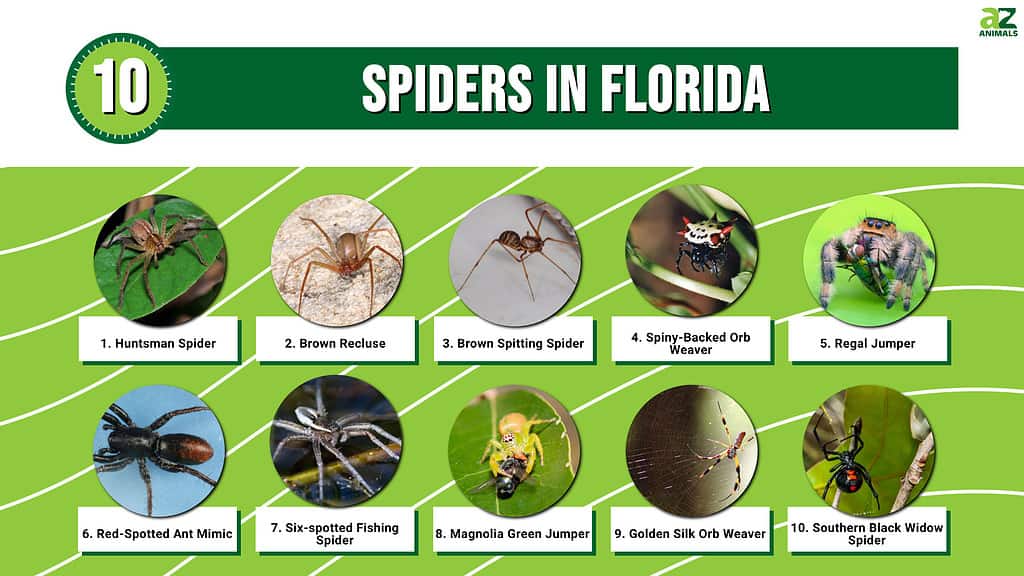
Florida is home to some of the most fascinating creatures found in North America, from manatees to roseate spoonbills. Still, some of its most incredible creatures are often the ones hidden right under our noses. There is an incalculable number of spider species that call Florida home. From orb weavers to nursery spiders and jumping spiders, the state has its fair share of spider species. It also shelters some of the most venomous and largest spiders in North America. If you’re a Florida native or planning to visit Florida sometime soon, you’ll want to know just what sort of critters you can expect to find while wandering through the woods or sorting clothes in your closet. This is why we’ve compiled this list of 10 spiders in Florida that will give you a taste of Florida’s arachnid diversity.
#10: Southern Black Widow Spider

The southern black widow spider features a red hourglass-shaped marking on its abdomen.
©Jay Ondreicka/Shutterstock.com
Almost no spider in North America strikes fear into people’s hearts as much as the black widow spider. One such black widow that you can find in Florida is the southern black widow spider, which produces venom that affects its prey’s nervous system. While rarely fatal to humans, bites can cause muscle aches, nausea, and difficulty breathing.
The southern black widow spider is the largest venomous spider in Florida. Females grow to sizes between 3.75 to 5 centimeters long, with bodies around 1.25 centimeters long. You can identify the females by their distinctive black bodies and the red hourglass-shaped marking on their abdomens, and by the large webs, they create to capture prey and hold their eggs.
Widow spiders get their name from the supposed belief that the females kill and cannibalize the males shortly after mating. While observed, this practice is not ubiquitous.
#9: Golden Silk Orb Weaver
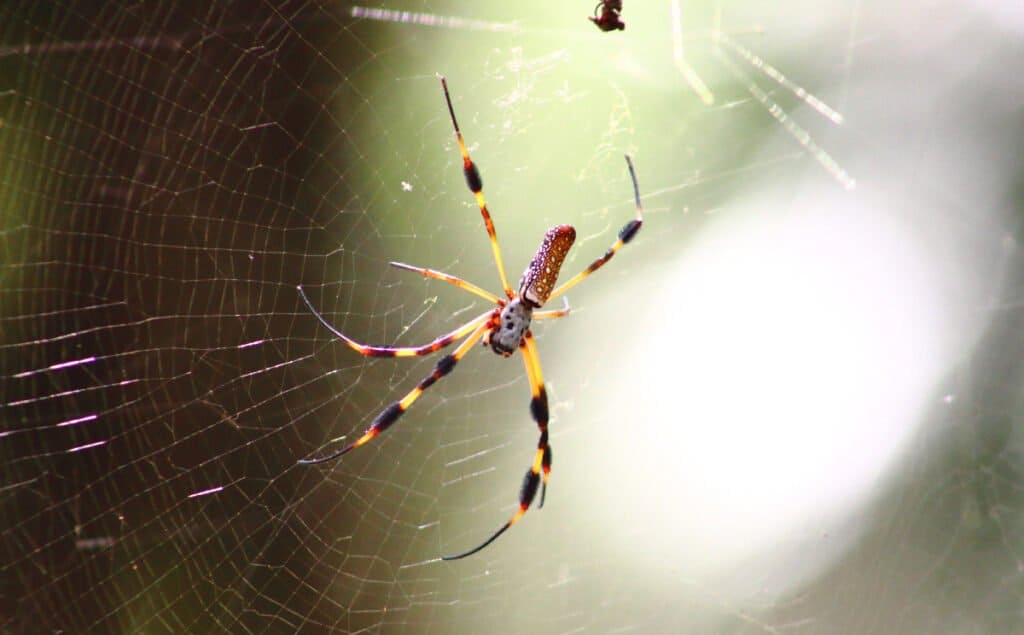
The golden silk
orb weaver
builds a web that measures nearly 5 feet in diameter
©Max Rossa/Shutterstock.com
The golden silk orb weaver is one of the most common spiders in Florida, particularly in open woodlands or forests. Hikers and other nature enthusiasts often inadvertently walk into their sticky webs, which can reach nearly 5 feet in diameter. Their webs appear yellowish-gold in the sunlight, which is where they get their name. While walking into a web may be shocking, you are at no real threat if you are bitten by a golden silk orb weaver. Their bite is not poisonous, and usually only causes mild pain and some localized swelling.
Female golden silk orb weavers are quite large and their bodies regularly measure between 4.8 to 5.1 centimeters long. Meanwhile, the males are significantly smaller in comparison. Aside from their large size, you can identify female golden silk orb-weavers by their silvery carapace and yellow and brown-striped legs.
#8: Magnolia Green Jumper
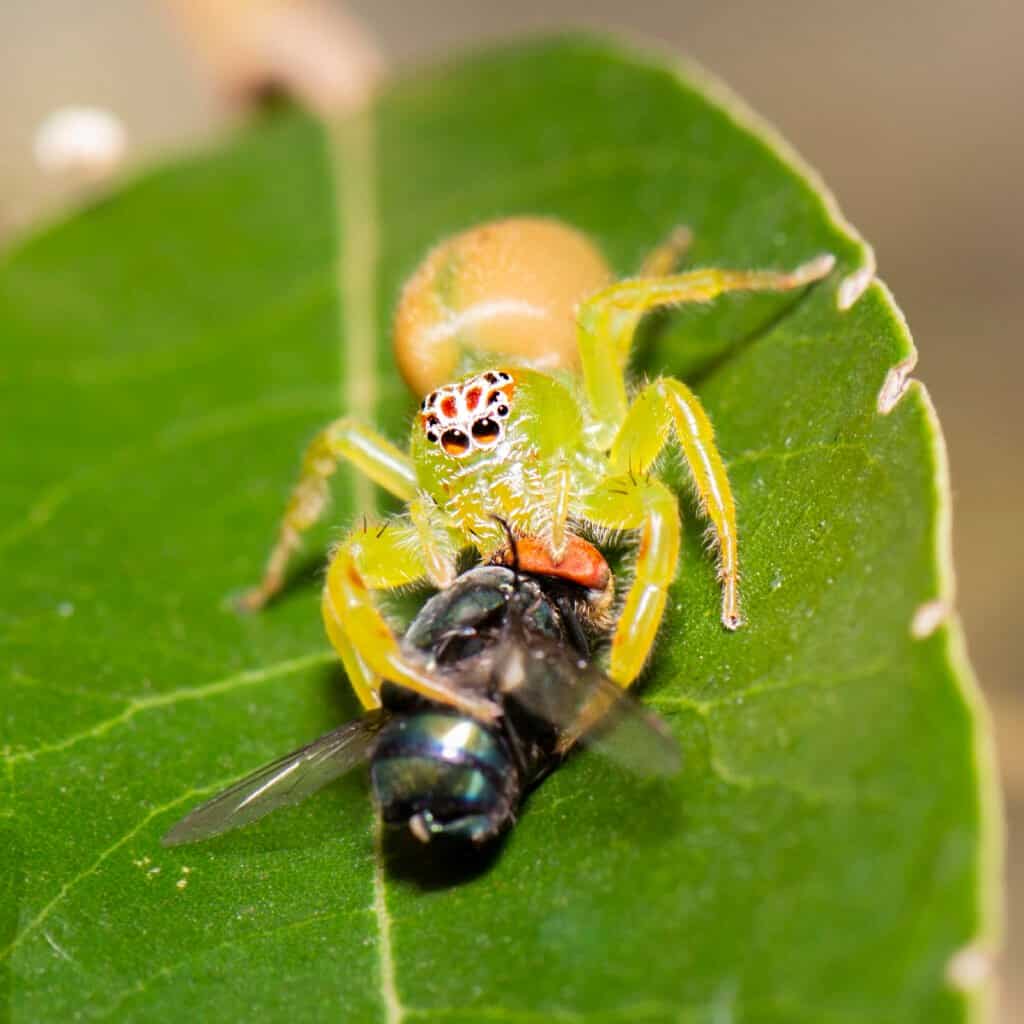
The magnolia green jumper gets its name from its bright green color and amazing jumping ability
©iStock.com/RobertDowner
The magnolia green jumper is the type species of the genus Lyssomanes, from which it gets its name, Lyssomanes viridis. Its genus is thought to be one of the first genera of jumping spiders, making it of particular interest for tracing the evolution of spider morphology.
Magnolia green jumpers get their name from their distinctive translucent green color. Females measure around 7 to 8 millimeters long, while males measure slightly smaller at 5 to 6 millimeters in length. Although they cannot jump as far as some other jumping spiders, they possess longer legs relative to their body size than other jumpers. Additionally, they still possess large chelicerae, or mouthparts, which are a distinct feature of jumping spiders and are often used in mating contests.
You can usually find them on leaves both on trees or bushes, where they like to both ambush their prey and build their nests.
#7: Six-Spotted Fishing Spider
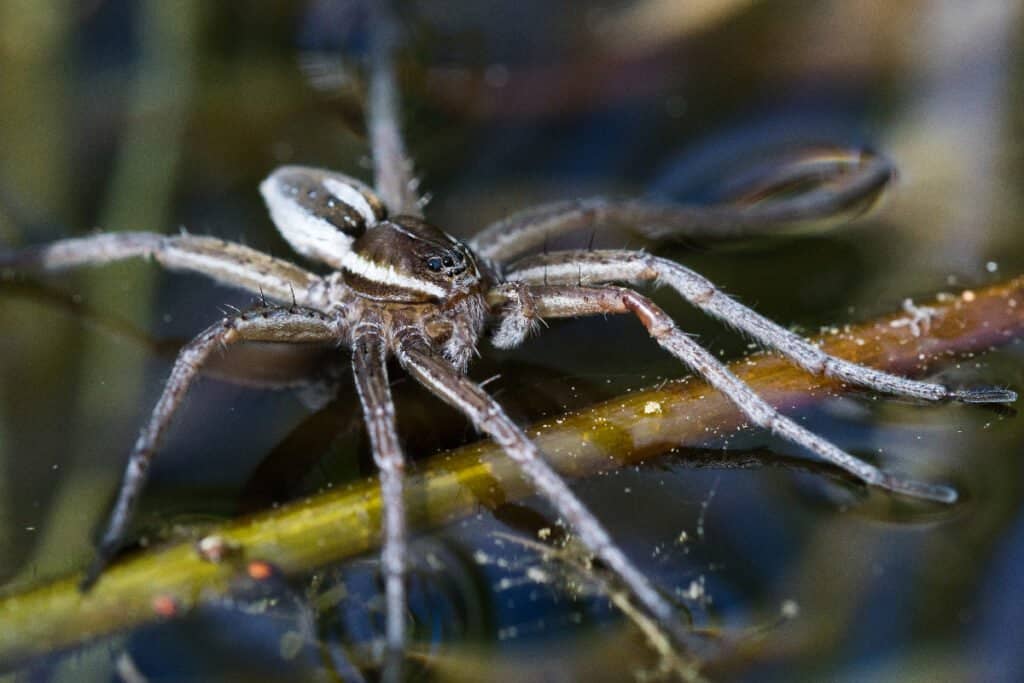
The six-spotted
fishing spider
can catch fish more than five times its own size
©Jukka Jantunen/Shutterstock.com
The six-spotted fishing spider belongs to the nursery web spider family Pisauridae. You’re most likely to encounter these spiders in Florida wetlands and near ponds. They are also called dock spiders, due to their habit of living near boat docks.
Females can reach up to 60 millimeters long, with a body length ranging from 15 to 20 millimeters. Meanwhile, males measure between 9 to 13 millimeters long. Their bodies appear grey or brown, and sport two light lines running down each side of the abdomen. They also sport six dark spots underneath their abdomen, which is where they get their name.
Six-spotted fishing spiders are one of the few spiders capable of catching vertebrate prey. They can catch fish measuring five times their size, which they kill using their venomous bite. While hunting, they will either wait near the water’s surface or dive underwater to catch their prey.
#6: Red-Spotted Ant Mimic
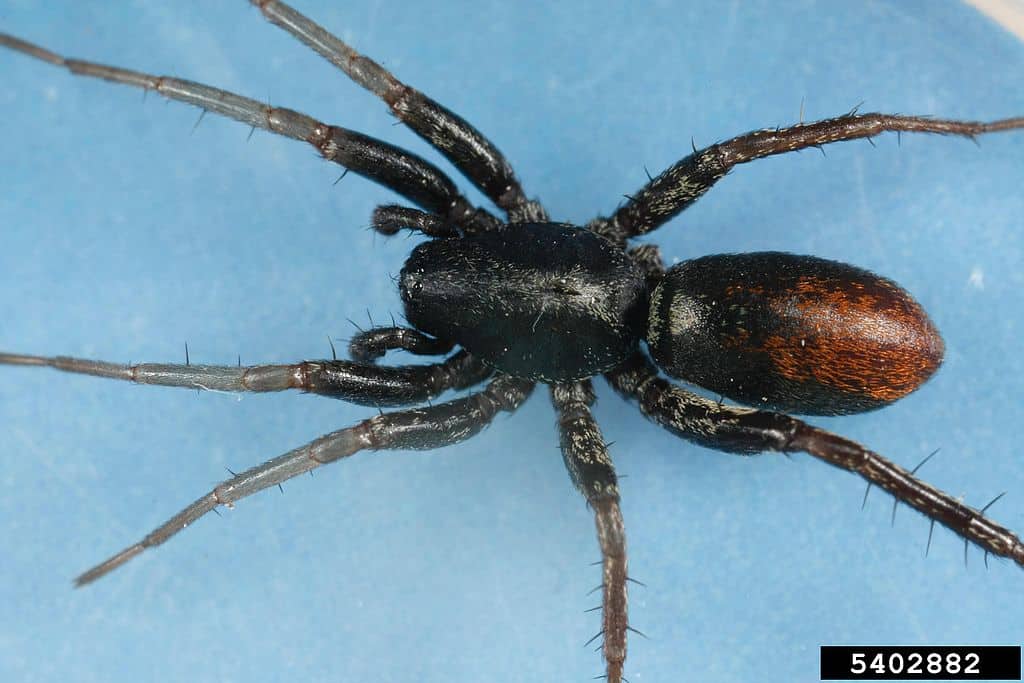
The red-spotted ant mimic disguises itself to look like an ant
©Joseph Berger, Bugwood.org; University of Georgia / CC BY 3.0, via Wikimedia Commons – License
The red-spotted ant mimic gets its name from its habit of imitating the appearance of an ant. Unlike other spiders, this curious creature walks on six legs instead of eight and uses its front two legs like antennae. This causes it to blend in with ants, who think that the spider is one of them, allowing the spider to ambush the unaware ants.
Female red-spotted ant mimics measure from 5 to 13 millimeters long, with the males measuring smaller. They feature a black body with a reddish-brown abdomen and a white line running down the middle of their carapace.
Red-spotted ant mimics often make their nests in shrubs, parks, and wooded areas close to ant hills. While their venom is deadly to small insects it is harmless to humans and produces only mild pain.
#5: Regal Jumper
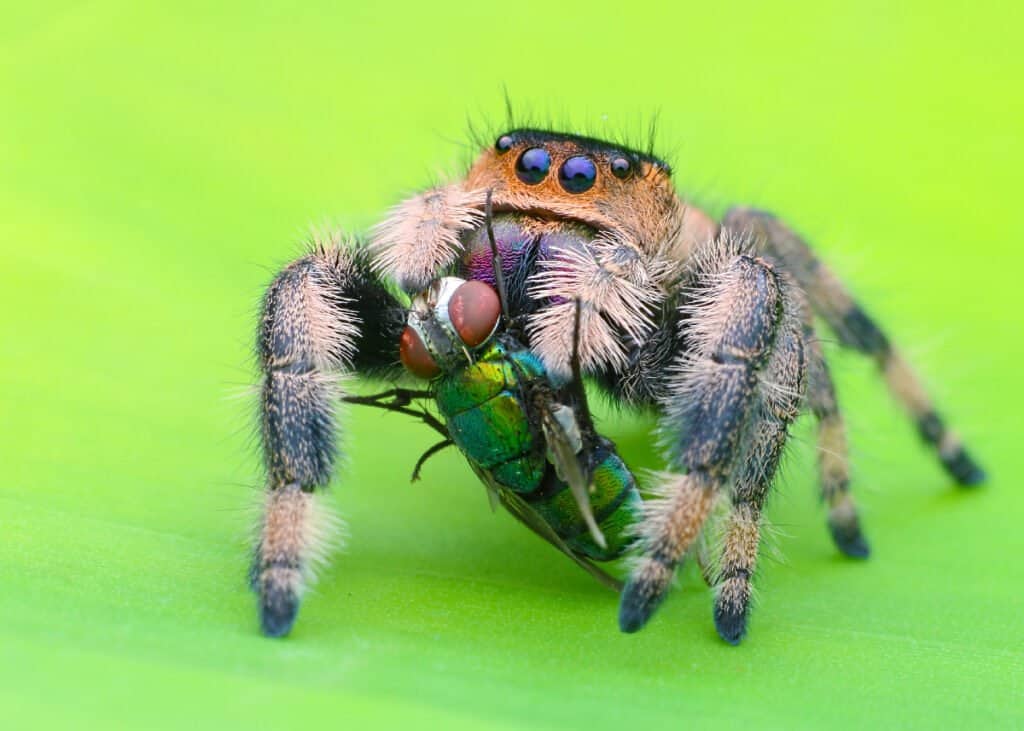
The regal jumping spider is the largest species of jumping spider found in the eastern United States
©Farid Irzandi/Shutterstock.com
Phidippus regius, or the regal jumper, is one of the species of jumping spiders in Florida. It gets its name, not from a royal decree, but because it is the largest species of jumping spider found in the eastern United States. Males measure from 6 to 18 millimeters long, while females range from 7 to 22 millimeters in length. While males typically appear black with white spots and stripes, females vary from gray to reddish-orange in color. Both males and females feature three dots on their abdomens that look similar to a smiling face.
You’ll most likely encounter a regal jumper in fields or lightly wooded areas, particularly near trees or buildings. They prefer to build their nests in secluded areas with plenty of covers, but will hunt in open areas where they can easily pounce on their prey. While not poisonous, their bite can still be painful to humans.
#4. Spiny-Backed Orb Weaver

The spiny-backed orb weaver is also called the star spider due to its spiky appearance
©iStock.com/Weber
Also known as thorn spiders or star spiders, spiny-backed orb weavers are fascinating to behold. The females of the species possess brightly colored reddish spines on their white and black abdomens, which is where they get their name. They typically measure 5 to 9 millimeters long and around 10 to 13 millimeters wide. Meanwhile, the males do not have spines and are drabber in appearance and smaller in size.
Spiny-backed orb weavers prefer warm, wet climates, and often make their homes in lightly wooded areas. In particular, they seem to enjoy spinning their webs in citrus orchards, which makes sense why you can find these spiders in Florida. Given that they prey on pests and pose little threat to humans, spiny-backed orb weavers are considered beneficial to humans. Unfortunately, they have short lifespans and rarely live longer than 9 to 12 months.
#3. Brown Spitting Spider
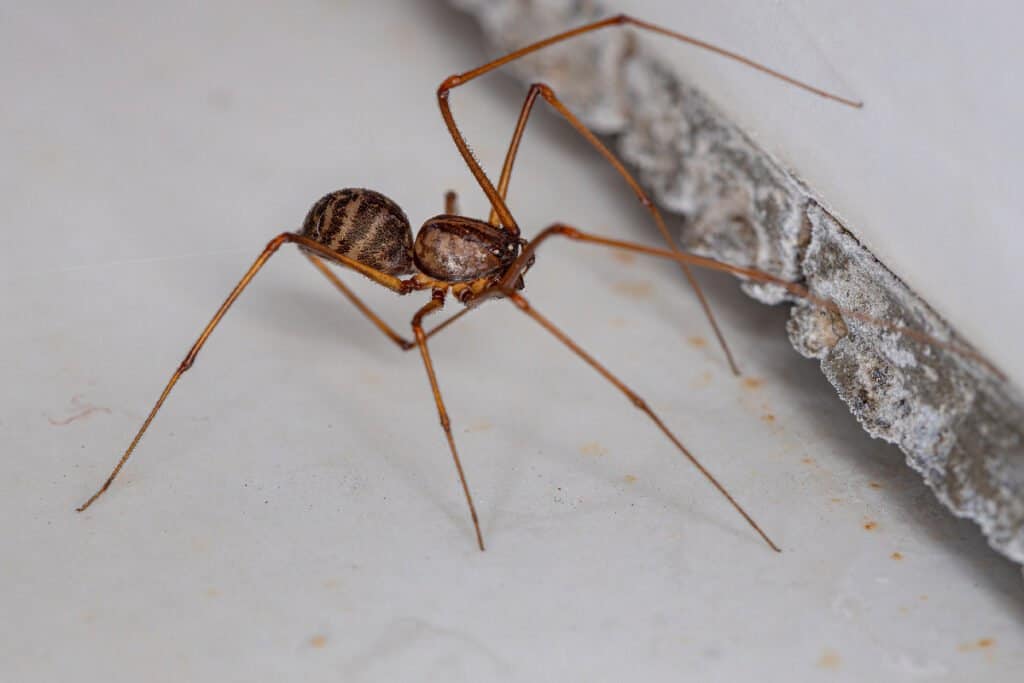
The brown spitting spider catches prey with venomous silk that it shoots from its abdomen
©iStock.com/ViniSouza128
The brown spitting spider is another spider that you’re likely to encounter if you spend enough time in Florida. Unlike most spiders, it features 6 eyes instead of the usual 8, and sports an unusually sloped carapace. Females range from 3 to 6 millimeters long, with the males measuring smaller. They typically look light brown in color, and sport black markings on the body and dark stripes on the legs.
The brown spitting spider is unique among spiders in its method of catching prey. Compared to other spiders, it is very slow and does not catch prey with a web or by jumping. Instead, it ambushes its prey by firing venomous silk from its abdomen from about 10 millimeters away. The silk immobilizes the prey, enabling the spider to then feast on it at its leisure.
#2: Brown Recluse
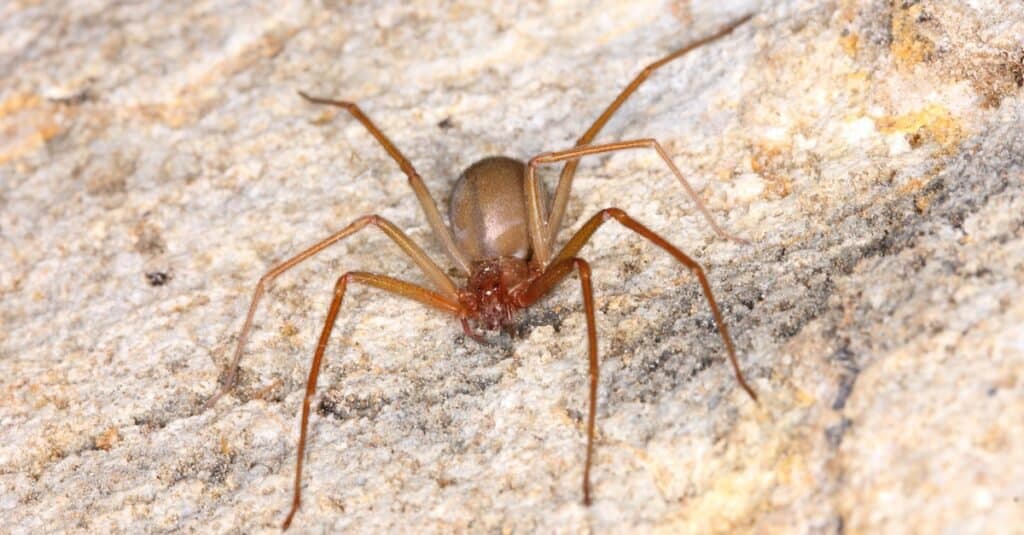
The brown recluse’s venom destroys the walls of blood vessels near the site of the bite, sometimes causing a large skin ulcer.
©Pong Wira/Shutterstock.com
Another poisonous spider in Florida is the brown recluse. This spider can deliver necrotic venom which may cause nausea, vomiting, muscle aches, fever, and even death. That said, brown recluses rarely bite, unless pressed up against the skin. Their bites are usually only fatal to children or people with weak immune systems.
Brown recluses measure between 6 and 20 millimeters long and vary in appearance from light to dark brown or gray. They possess dark markings which look similar to a violin, lending it its nickname the fiddle back or violin spider.
You’ll most likely encounter a brown recluse in dry, secluded spaces, which is where they like to build their irregular-shaped webs. Common areas include woodpiles, sheds, closets, garages, and cellars. At night, they leave their webs to hunt, which is a rare trait among web-weaving spiders.
#1. Huntsman Spider

The
huntsman spider
is the largest species of spider found in Florida.
©Pong Wira/Shutterstock.com
Also known as giant crab spiders due to their size and appearance, huntsman spiders are the largest spiders in Florida. Females typically measure between 3 to 5 inches long, but especially large specimens can reach nearly 6 inches in length. Their bodies typically appear grey or brown but often carry black, white, or red markings on the abdomens.
Unlike many other spiders, huntsman spiders do not spin webs. Instead, they hunt and scavenge for food, and rely on their quick speed and dexterity to run down and catch their prey. They will prey on not only insects but also small vertebrates including lizards.
Originally from Asia, huntsman spiders are considered an invasive species in Florida. Thanks to its hospitable warm, wet weather, these giant spiders have found a new home in the Sunshine State. Thankfully, their bite isn’t fatal to humans, although it can cause nausea and headaches.
Summary Of The 10 Spiders In Florida
| Rank | Spider | Severity Of Bite |
|---|---|---|
| 10 | Southern Black Widow Spider | Venomous & can cause muscle aches, nausea, and difficulty breathing |
| 9 | Golden Silk Orb Weaver | Non-venomous & only causes mild pain and some localized swelling |
| 8 | Magnolia Green Jumper | Non-venomous & may only cause mild redness and irritation |
| 7 | Six-spotted Fishing Spider | Not toxic to humans & typically no more severe than a bee or wasp sting |
| 6 | Red-Spotted Ant Mimic | Non-toxic to humans, produces only a mild pain |
| 5 | Regal Jumper | Not poisonous but their bite can still be painful to humans |
| 4 | Spiny-Backed Orb Weaver | Not poisonous & typically no more severe than a bee |
| 3 | Brown Spitting Spider | Not poisonous & can not bite humans |
| 2 | Brown Recluse | Necrotic venom which may cause nausea, vomiting, muscle aches, fever, and even death |
| 1 | Huntsman Spider | Non-venomous but causes nausea & headaches |
The photo featured at the top of this post is © Sari ONeal/Shutterstock.com
Thank you for reading! Have some feedback for us? Contact the AZ Animals editorial team.






